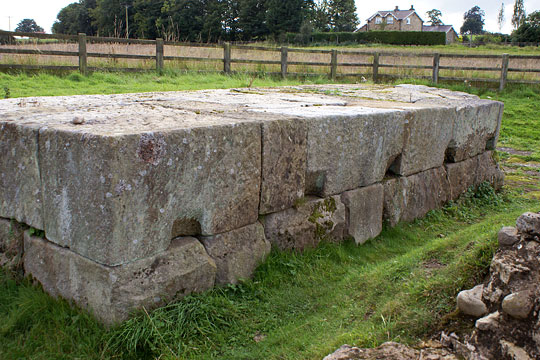Description of Piercebridge Roman Bridge
As excavated, and visible today, Piercebridge Roman Bridge consists of several elements: the abutment at the south end; the masonry piers that carried the structure over the river, supported by a pavement; and a causeway which replaced the southern part of the bridge after the river had shifted northwards.

Bridge Abutment
The most southerly element is the bridge abutment located on the line of the Roman-period south bank of the river. It consists of two layers of well-cut stone blocks, each up to 1.5 metres long, and mostly of millstone grit, but with some of sandstone. Overall it was 8.05 metres by 3.1 metres in area and 1.2 metres high, and incorporates a cutwater on the upstream side. The riverside face (excluding the cutwater) is 6.1 metres wide, which gives us the probable width of the bridge. The riverside face of the abutment includes angled slots that may have held timbers which supported a wooden deck to the bridge.
Pavement and Piers
The abutment is built on a stone pavement up to 0.35 metres thick and 14 metres wide. This extends northwards from the abutment and formed a base for the piers that supported the superstructure of the bridge as it crossed the river.
The piers were between 10.5 metres and 12.1 metres apart. The two southernmost piers were completely removed at some point during the later Roman period (see below). Pier 3 survives as a jumbled mass of stone, but Pier 4 is fairly intact. The upper stones of the pavement were levelled to provide a firm base for Pier 4, which was 4.53 metres wide and about 7.3 metres long. There is evidence of a cutwater on the upstream side of the pier, but it is clear that the downstream side was square.
Many of the stones in the piers have holes that may have accommodated metal dowels to hold the stones in place. They also incorporate iron clamps set in lead to hold the stones together, as did the upstream-facing edge of the cutwater of the abutment.
Causeway
During the Roman period the river shifted north, and the southern part of the bridge was replaced with a causeway. Part of the causeway survives as a layer of cobbles and large pieces of dolomite, which overlie a layer of alluvium that had accumulated between the piers. The cobbles and dolomite formed a level with limestone slabs that sealed a soil layer overlying the stone bridge abutment.
The excavation of the bridge showed that Piers 1 and 2 had been removed in the Roman period, before the causeway was laid, and probably sometime after about AD 320. It is possible that the piers were reused as the bridge was extended northwards across the new course of the river.
READ MORE ABOUT PIERCEBRIDGE ROMAN BRIDGE